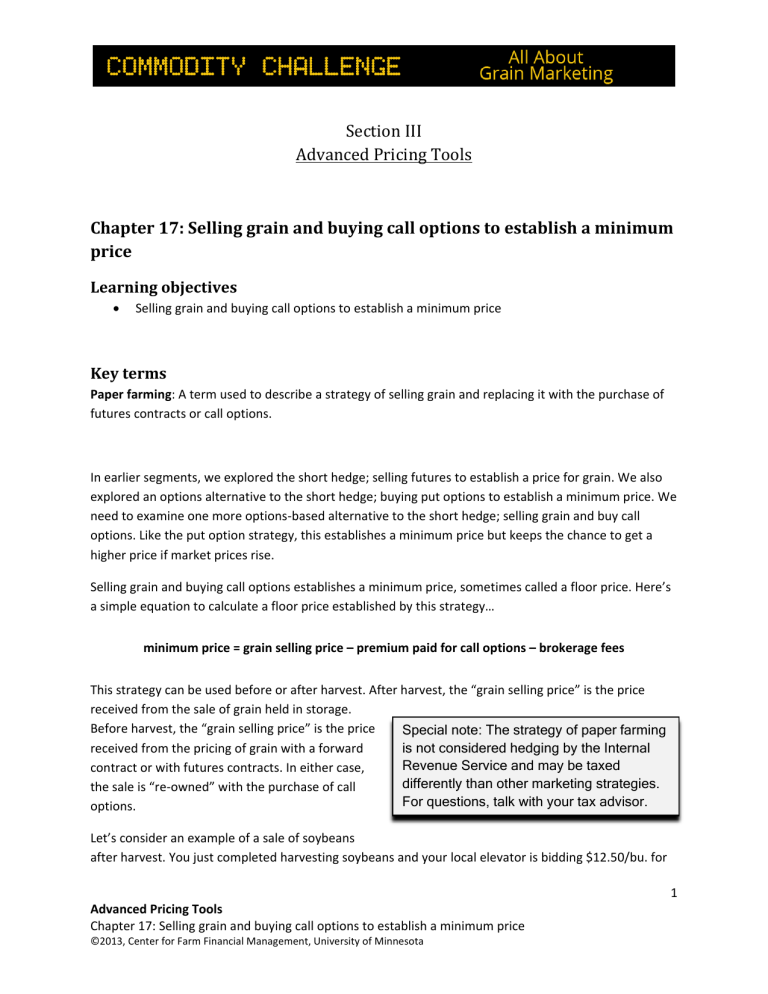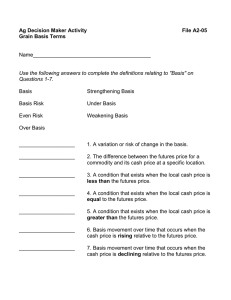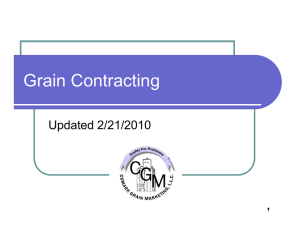Section III Advanced Pricing Tools Chapter 17: Selling grain and

Section III
Advanced Pricing Tools
Chapter 17: Selling grain and buying call options to establish a minimum price
Learning objectives
Selling grain and buying call options to establish a minimum price
Key terms
Paper farming : A term used to describe a strategy of selling grain and replacing it with the purchase of futures contracts or call options.
In earlier segments, we explored the short hedge; selling futures to establish a price for grain.
We also explored an options alternative to the short hedge; buying put options to establish a minimum price.
We need to examine one more options ‐ based alternative to the short hedge; selling grain and buy call options.
Like the put option strategy, this establishes a minimum price but keeps the chance to get a higher price if market prices rise.
Selling grain and buying call options establishes a minimum price, sometimes called a floor price.
Here’s a simple equation to calculate a floor price established by this strategy… minimum price = grain selling price – premium paid for call options – brokerage fees
This strategy can be used before or after harvest.
After harvest, the “grain selling price” is the price received from the sale of grain held in storage.
Before harvest, received contract the sale options.
or is from
with
“re ‐
the the
“grain pricing futures owned”
selling of contracts.
with
grain the
price” with
In
a is either purchase
the price forward of
case, call
Special note: The strategy of paper farming is not considered hedging by the Internal
Revenue Service and may be taxed differently than other marketing strategies.
For questions, talk with your tax advisor.
Let’s consider an example of a sale of soybeans after harvest.
You just completed harvesting soybeans and your local elevator is bidding $12.50/bu.
for
1
Advanced Pricing Tools
Chapter 17: Selling grain and buying call options to establish a minimum price
©2013, Center for Farm Financial Management, University of Minnesota
$13.20
$12.80
$12.40
$12.00
$11.60
Futures
Market
$14.80
$14.40
$14.00
$13.60
immediate delivery.
November futures are trading at $13.20/bu.
and basis is 70 cents under the
November contract.
That’s a good price for soybeans, but you’re concerned that prices could trade even higher in the months ahead.
With May soybean futures trading at the same price as November soybeans
($13.20/bu.), you decide to price 20,000 bushels of soybeans at $12.50/bu.
and place an order with your broker to buy “at ‐ the ‐ money” 1320 May calls.
The sale of soybeans and repurchase with call options are generally done at the same time.
The premium is 83 cents per bushel.
Brokerage fees are ignored.
Forward Contract and Buy Call Options to Establish a Minimum Price
Date Cash Options Basis/Min.
Price
October Sell soybeans to
20,000 the
at local
bushels
of elevator.
$12.50/bu.
With May futures trading at $13.20, buy four May
1320 call options for 83 cents per bushel.
Minimum price: $12.50
forward contract ‐ .83
premium =
$11.67/bu.
Here is how the purchased option strategy performs at various futures price outcomes.
If the futures price trend higher, the value of the 1320 May call increases, and this increase in value represents your potential to gain from a rising market.
If the futures price trend lower, the value of the 1320 May call decreases, but your original sale price does not change.
The most you can lose is the premium paid for the call.
$13.20
call value
1.60
1.20
0.80
0.40
0.00
0.00
0.00
0.00
0.00
‐ option premium paid
= net call value
0.83
0.77
0.83
0.83
0.83
0.83
0.83
0.83
0.83
0.83
‐
‐
‐
‐
‐
‐
‐
0.37
0.03
0.43
0.83
0.83
0.83
0.83
0.83
+ selling price
12.50
12.50
12.50
12.50
12.50
12.50
12.50
12.50
12.50
= cash estimate
$13.27
$12.87
$12.47
$12.07
$11.67
$11.67
$11.67
$11.67
$11.67
2
Advanced Pricing Tools
Chapter 17: Selling grain and buying call options to establish a minimum price
©2013, Center for Farm Financial Management, University of Minnesota
Buying put options vs.
selling grain and buying call options – two different ways to establish a minimum price.
How do I decide which way is best?
Good question!
Let’s look for an answer.
We start by reconsidering the example, this time buying put options to establish a minimum price.
As in the original example, you completed harvesting soybeans and your local elevator is bidding
$12.50/bu.
for immediate delivery.
November and May futures are trading at the same price,
$13.20/bu.
You decide to store 20,000 bushels of soybeans (current price of $12.50/bu.) and place an order with your broker to buy “at ‐ the ‐ money” 1320 May puts – the right to sell May futures at
$13.20/bu.
You expect the basis, currently trading at 70 cents under the November to narrow to 40 cents under the May by next April.
The premium is 83 cents per bushel, the same as the May 1320 calls.
Brokerage fees are ignored.
Forward Contract and Buy Call Options to Establish a Minimum Price
Date Cash Options Basis/Min.
Price
October Store 20,000
$12.50/bu.
bushels of soybeans on the farm.
Current value is
With May futures trading at $13.20, buy four May
1320 put options for 83 cents per bushel.
Expected basis next April is ‐
$0.40, or 40 cents under the May contract.
Minimum expected price next spring: $13.20
strike + ( ‐ $0.40) basis ‐ .83
premium = $11.97
Buying put options vs.
selling grain and buying call options – which way is best?
We have an answer.
The store grain and buy puts alternative established a minimum price of $11.97, 30 cents per bushel than the sell grain and buy call options strategy (11.67/bu.).
Clearly, buying puts is the better alternative – or is it?
We can’t be certain because this simple comparison overlooks three important factors; storage costs, basis and taxes.
The put option alternative involves storing soybeans six months, and the analysis ignored storage costs.
What does it cost to store grain?
Storage on the farm will cost 30 cents per bushel or more, considering interest costs and grain shrink.
Paper farming involves selling grain at harvest and eliminating interest and shrink.
Any comparison of buying puts vs.
paper farming must consider storage costs.
Basis risk and potential should also be considered.
Buying puts established an expected minimum price of $11.97/bu., based on an expected basis of 40 cents under the May.
What if basis is actually weaker than expected, e.g.
50 cents vs.
40 cents under?
Then again, maybe basis will be stronger than expected, resulting in a price higher than expected.
There is no basis mystery in the paper farming example – the basis is known when grain is sold.
As you choose between buying puts and paper farming, the confidence you have in your basis expectations is very important.
3
Advanced Pricing Tools
Chapter 17: Selling grain and buying call options to establish a minimum price
©2013, Center for Farm Financial Management, University of Minnesota
Finally, tax issues must be considered.
The paper farming strategy creates income in the harvest year, while storing grain defers income into the next year.
Paper farming ‐ selling grain and replacing it with the purchase of call options – adds another pricing tool to your toolbox.
It works best when basis is strong and the futures market show small carrying charges or inverses.
Further reading
Self ‐ Study Guide to Hedging with Grain and Oilseed Futures and Options (handbook), CME Group, April
2012 http://www.cmegroup.com/trading/agricultural/self ‐ study ‐ guide ‐ to ‐ hedging ‐ with ‐ grain ‐ and ‐ oilseed ‐ futures ‐ and ‐ options.html
Grain and Oilseed Futures and Options (brochure), CME Group, February 2012 http://www.cmegroup.com/trading/agricultural/grain ‐ and ‐ oilseed ‐ futures ‐ and ‐ options ‐ fact ‐ card.html
Advanced Pricing Tools
Chapter 17: Selling grain and buying call options to establish a minimum price
©2013, Center for Farm Financial Management, University of Minnesota
4
Exercise #17
At harvest, you decide to sell your newly harvested soybeans and buy 6 call option contracts on May soybeans to lock in a minimum price on 30,000 bushels of soybeans, while retaining the possibility of a higher price, should prices trend higher in the months ahead.
I want you to complete the transaction next spring, under three different scenarios.
Fill in the blanks in the T ‐ diagram, showing the price you received in $/bushel or in gross sales revenues (price * quantity).
Ignore ownership (storage) costs.
Scenario #1: Futures prices change little from harvest to spring
Date
October
Cash Options Basis
Harvest 30,000 bushels of soybeans.
Your local elevator is bidding
$12.35/ bu.
Make the sale and re ‐ own soybeans with the purchase of call options on May futures.
With May futures trading at $13.00/bu., the producer buys 6 contracts of 1300 May call options, at a premium of $1.01/bu.
Minimum price established
(aka worst case scenario) is
$12.35
‐ $1.01
‐ $.01
=
$11.33/bu.
mid ‐ April (just before expiration of
May options)
NA
Results What did you receive in the cash market?
$/bu.
_____________
$total _____________
With May soybean futures at $12.70/bu., the
1300 calls are worth less than 1 cent/bu.
Let them expire.
NA
What loss on
$/bu.
$total
was
the your
put
gain or
_____________
_____________
options?
What final price did you receive for your corn?
$/bu.
_____________
$total _____________
5
Advanced Pricing Tools
Chapter 17: Selling grain and buying call options to establish a minimum price
©2013, Center for Farm Financial Management, University of Minnesota
Scenario #2: Futures prices rise $1/bu.
from harvest to spring
Date
October
Cash Futures
Harvest 30,000 bushels of soybeans and sell to your local elevator for
$12.35/ bu.
May futures trading at
$13.00/bu., buys 6 contracts of 1300 May call options, at a premium of $1.01/bu.
Basis
Minimum price established
(aka worst case scenario) is
$12.35
‐ $1.01
‐ $.01
=
$11.33/bu.
mid ‐ April (just before expiration of
May options)
NA
Results
With May soybean futures at $14.00/bu., the 1300 calls are worth
$1/bu.
– sell options for a $1/bu.
gain.
NA
What did you receive in the cash market?
$/bu.
_____________
$total _____________
What was your gain or loss on the put options?
$/bu.
_____________
$total _____________
What final price did you receive for your corn?
$/bu.
_____________
$total _____________
Advanced Pricing Tools
Chapter 17: Selling grain and buying call options to establish a minimum price
©2013, Center for Farm Financial Management, University of Minnesota
6
Scenario #3: Futures prices fall $1/bu.
from harvest to spring
Date
October
Cash
Harvest 30,000 bushels of soybeans and sell to your local elevator for
$12.35/ bu.
Futures
May futures trading at
$13.00/bu., buys 6 contracts of 1300 May call options, at a premium of $1.01/bu.
Basis
Minimum price established
(aka worst case scenario) is
$12.35
‐ $1.01
‐ $.01
=
$11.33/bu.
mid ‐ April (just before expiration of
May options)
NA
Results
With May soybean futures at $12.00/bu., the 1300 calls have lost all value – let them expire worthless.
NA
What did you receive in the cash market?
$/bu.
_____________
$total _____________
What was your gain or loss on the put options?
$/bu.
_____________
$total _____________
What final price did you receive for your corn?
$/bu.
_____________
$total _____________
Advanced Pricing Tools
Chapter 17: Selling grain and buying call options to establish a minimum price
©2013, Center for Farm Financial Management, University of Minnesota
7




